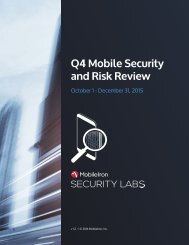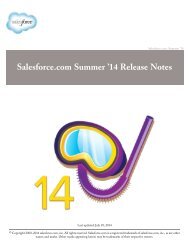salesforce_security_impl_guide
salesforce_security_impl_guide
salesforce_security_impl_guide
Create successful ePaper yourself
Turn your PDF publications into a flip-book with our unique Google optimized e-Paper software.
CHAPTER 4<br />
Enabling Single Sign-On<br />
Salesforce offers several ways to use single sign-on:<br />
• Federated authentication using Security Assertion Markup Language (SAML) allows you to send authentication and authorization<br />
data between affiliated but unrelated Web services. This enables you to sign on to Salesforce from a client application. Federated<br />
authentication using SAML is enabled by default for your organization.<br />
• Delegated authentication single sign-on enables you to integrate Salesforce with an authentication method that you choose. This<br />
enables you to integrate authentication with your LDAP (Lightweight Directory Access Protocol) server, or perform single sign-on<br />
by authenticating using a token instead of a password. You manage delegated authentication at the permission level, allowing some<br />
users to use delegated authentication, while other users continue to use their Salesforce-managed password. Delegated authentication<br />
is set by permissions, not by organization.<br />
The primary reasons for using delegated authentication include:<br />
– Using a stronger type of user authentication, such as integration with a secure identity provider<br />
– Making your login page private and accessible only behind a corporate firewall<br />
– Differentiating your organization from all other companies that use Salesforce in order to reduce phishing attacks<br />
You must request that this feature be enabled by <strong>salesforce</strong>.com. Contact <strong>salesforce</strong>.com to enable delegated authentication single<br />
sign-on for your organization.<br />
• Authentication providers let your users log in to your Salesforce organization using their login credentials from an external service<br />
provider. Salesforce supports the OpenId Connect protocol that allows users to log in from any OpenID provider such as Google,<br />
Paypal, LinkedIn and other services supporting OpenID Connect. When authentication providers are enabled, Salesforce does not<br />
validate a user’s password. Instead, Salesforce uses the user’s login credentials from the external service provider to establish<br />
authentication credentials.<br />
Benefits of Single Sign-On<br />
Implementing single sign-on can offer the following advantages to your organization:<br />
• Reduced Administrative Costs: With single sign-on, users only need to memorize a single password to access both network<br />
resources or external applications and Salesforce. When accessing Salesforce from inside the corporate network, users are logged<br />
in seamlessly, without being prompted to enter a username or password. When accessing Salesforce from outside the corporate<br />
network, the users’ corporate network login works to log them in. With fewer passwords to manage, system administrators receive<br />
fewer requests to reset forgotten passwords.<br />
• Leverage Existing Investment: Many companies use a central LDAP database to manage user identities. By delegating Salesforce<br />
authentication to this system, when a user is removed from the LDAP system, they can no longer access Salesforce. Consequently,<br />
users who leave the company automatically lose access to company data after their departure.<br />
• Time Savings: On average, a user takes five to 20 seconds to log in to an online application; longer if they mistype their username<br />
or password and are prompted to reenter them. With single sign-on in place, the need to manually log in to Salesforce is avoided.<br />
These saved seconds add up to increased productivity.<br />
• Increased User Adoption: Due to the convenience of not having to log in, users are more likely to use Salesforce on a regular basis.<br />
For example, users can send email messages that contain links to information in Salesforce.com such as records and reports. When<br />
the recipients of the email message click the links, the corresponding Salesforce.com page opens automatically.<br />
89






